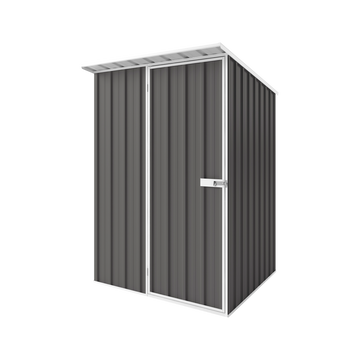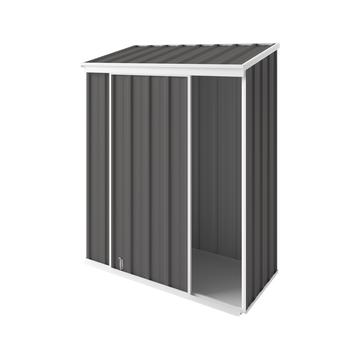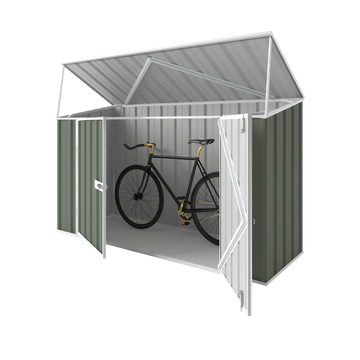Whether you’re an experienced artist or are just starting out, there’s nothing more exciting than the idea of your own personal artist’s cave. A place where you can tap into your creativity without distractions. A place where you can see all of your artist’s tools on display. A place where you can watch your latest painting dry or fire up the kiln or watch your empty loom become an intricate tapestry.
But if you take a look at your shed as it is, you may have a hard time imagining that it could be the artist’s retreat that you want. So, in this article, we’re going to talk about why your backyard shed is the perfect place for your future studio, and how to make it come alive in no time.
First of all, what makes the shed the right place for an art studio?
Right now, you may be working in a room in your house. And for many people, that’s just fine.
But, there are a few things about being at home that can stunt creativity.
To begin, your home, as peaceful and calming as it may be, is full of distractions. That pile of laundry starts to stare at you. The phone rings. The television tempts you. The dishes need cleaning.
You may be thinking, the distractions aren’t going to go away just because I’m a few steps outside of the house, but you’d be surprised at how much easier it is to focus when you put even just a bit of physical space between yourself and your home. As the old saying goes, out of sight, out of mind.
Now, consider the benefits of having a shed that is 100% dedicated to your artistic pursuits. When you enter your shed, your brain will start to recognize, now is the time to be creative. It’s a bit like arriving at your work desk everyday. Being in that particular location triggers your brain to fire up the creative juices.
Lastly, there’s a benefit of your shed being in the backyard. This is a space that is open to nature. You can open it up to feel the breeze. You can look out the window or door and see interesting things like the birds or your flowerbed. Often, when we hit a lull in our creative process in the house, the brain will wander to the things at home that need to be done. Out in the shed though, that downtime allows for peacefulness and reflection.
How can you make it happen?
It’s clear that having a backyard shed that doubles as an artist studio is a great way to boost creativity and invest in yourself as an artist. So how can you go about transforming that space into a fully-equipped studio? Well it’s going to take some planning, some organization, and some creative choices, but you’ll have your art studio before you know it.
Let’s break it down into easy steps:
Start with the bare bones
Maybe you already have a shed that is full of stored items or garden equipment. Or, maybe you’re on the market for a new shed. Either way, you’ll want to start out with a completely empty space.
If you’re in the first boat, you have a bit of organization to do. As much as you can, you’ll want to get rid of anything that you don’t need. Donate any old clothes that you’re storing in your shed. Consolidate those multiple bags of potting soil and store opened bags of birdseed into smaller, easy-to-store containers.
Once you’ve gotten rid of everything that you can, you might find that you still have a few items leftover. Make sure that these items are stored in the most organized way possible. A good option is to put them in plastic bins that are not transparent but are clearly labeled. Stack them neatly or place them on storage shelves. You might also section them off with a folding screen room divider or hanging curtain. This is going to keep the items out of sight but still easily accessible.
If, on the other hand, you’re purchasing a brand new shed, you have a couple of other things to consider. You’ll want to choose a shed that is going to give you plenty of space for all of your art materials and more. After all, if you do decide to store other items in your shed, things can become crowded quickly, so always go for the larger option.
Placement in your backyard is also going to be important. Your artist shed should, of course, be on level ground. We recommend that you also angle your entry way and windows towards the part of your backyard you enjoy the most. Remember, creativity comes in cycles or waves, and in those downtimes, you’ll want a relaxing view.
If you have quite a large backyard space, you should consider how much distance you want between your studio and your home. One the one hand, the longer it takes to walk back to your home, the less likely it is that you’ll get pulled back into those household responsibilities. On the other hand, it’s no fun to run out to a far off shed on rainy days. The decision is entirely up to you.
Install your lighting system
Natural lighting and a lighting system are both going to be very important elements to your art studio.
As architect Donald Rattner explains, one of the best design elements you can implement in a space where you want to foster creativity is natural light. The idea is that light from the sun allows your body to follow its natural circadian rhythm, which will boost creativity and make you feel better overall. And, because good health is absolutely necessary for creativity, you’ll definitely want to make natural light a priority. Easyshed offers transparent roof panels, windows, and different door options so that you can maximize natural light.
Of course, natural light is not always going to be possible, so for a bit of extra light, here are a few other options:
- Battery-powered light bulbs. There are a few great options that you can stick on the wall of your shed that will give you plenty of light. You might also add in a few battery-powered string lights for a bit of extra light and ambiance.
- Underground electrical hookup. If you’re able to connect your shed to your home’s electric system, you can have whichever lamps or lanterns that you think would be best for your space. Hooking up a shed to electricity can be a bit of a big job, so make sure that you call in a professional for help.
- Solar-powered lights. This is a popular option because it saves money and installation isn’t too difficult depending on how much electricity you think you’ll need. The easiest option is to buy a light that attaches directly to the solar panel, but this will only give you a few hours of light per day. A more complex system will provide you with much more energy, in case you want to install internet or other electrical appliances for your studio. If you’re not sure how to install these larger solar-power systems yourself, you can call in an expert to help get you set up.
For more information on your lighting options, take a look at our blog post on lighting!
Create a layout
Alright, at this point, you have an empty shed and you have a lighting system. Time to move in and start creating, right? Well, it’s a good idea to have more of a plan for your art studio layout before you transition into your shed completely. Otherwise, you might find yourself spending more time trying to figure out where you put your materials instead of focusing on your projects.
First, figure out which materials you’ll be using. If you’re a painter, this might include: paints, jars, paintbrushes, canvases, notebooks, easels, pencils, aprons, etc. Or, if you’ll be using your shed for pottery, you might be using: clay, sculpting tools, glazes, a pottery wheel, a kiln, and drying racks. Make a full list of all of your materials, no matter how small. This will ensure that everything has a place when you move into your new art studio.
Next, you’re going to think about the best way you might store these materials. Loose erasers, buttons, sewing needles, charcoal, or other small items might go in small countertop drawer set or in an art case that has many different pouches. Larger items, like canvases, paper rolls, or printing screens, are best stored in specialized storage units that have many shelves to keep your work separated. Mason jars, coffee tins, and other containers are great for keeping your paintbrushes together. You can even mount these containers on the wall to keep your space more organized.
And of course, you’re going to want to have a clutter-free workspace. Depending on your medium, this might be a large table, an angled desk, an easel with a nearby side table, or a loom with a stool. Whatever your craft requires, make sure that you’re able to give it plenty of space and keep it clean and organized. It’s really difficult to access your creativity when you have to constantly be moving things out of the way.
In addition to the more obvious elements - the supply storage and the workspace - you’ll also want to have a space to store your finished projects. Every artist knows that there will be a period of time between finishing a project and selling/gifting/displaying it in which you’ll have to find a space for your work. So do yourself a favor and put extra storage into your floor plan.
One last thing about organization before we move on: make sure to tack up a wall calendar. Having your project deadlines or personal goals written out on a calendar that you can see every time you enter your shed is a huge benefit. It’s a simple addition to the space, but you’ll feel much more organized and accomplished!
Decorate
Now that the organization portion is out of the way, you can move onto the decorations. This isn’t an absolutely necessary step, but it can be helpful for the creative mind to see inspiration on the walls, and you’ll love coming into a space that you put effort into decorating in your personal style. It will make the whole place feel more like your own little retreat.
One of the best things that you can use to decorate your artist’s shed is plants. Plants can purify the air and make you feel at ease. And don’t worry if you don’t have a talent for taking care of plants. There are plenty that will survive with minimal maintenance. Try, for instance, a couple of spider plants, philodendron, snake plants, or peace lilies. These can all survive by giving them water once every one or two weeks, and they will do wonders for your space. Our only recommendation when it comes to plants is that you mount them on the wall or hang them from the ceiling. You don’t want a bunch of potted plants taking up counter or tabletop space.
You might also add some wall posters or wall hangings from artists that inspire you. Wall art with inspirational quotes are another great idea to boost creativity and help you stay motivated. Some other options might be scented candles, an area rug, and a music hookup.
Make art!
Believe it or not, it’s time to get to the most rewarding part of the entire process: making the art! You’ve thought about everything from shed placement, to lighting, to shelving, to decorations and it’s time to start doing what you love.
Take a moment to congratulate yourself on creating your very own art studio. You’ve made your dream come true!
If you found this article helpful and inspiring, share it with the members of your art community!



















